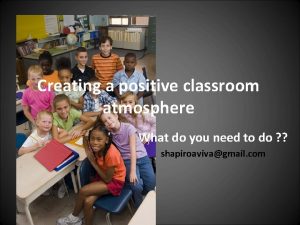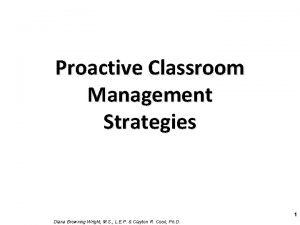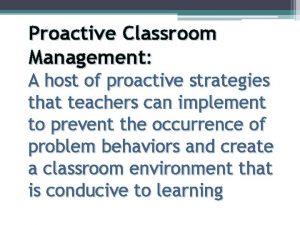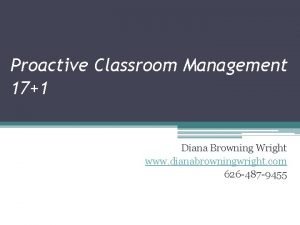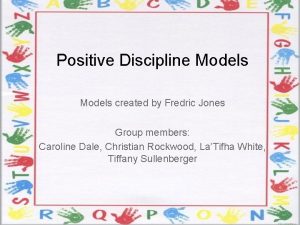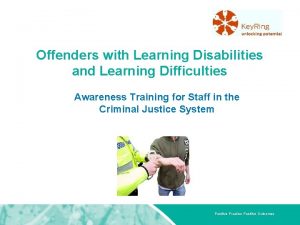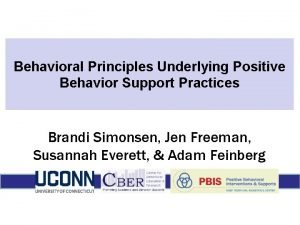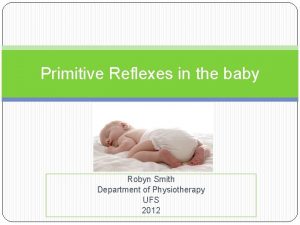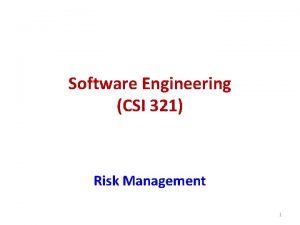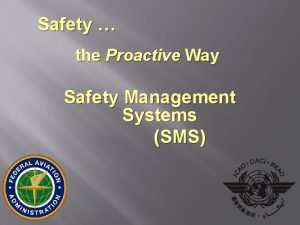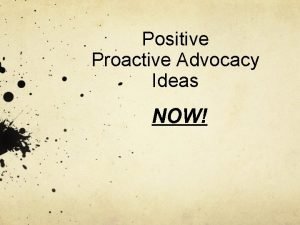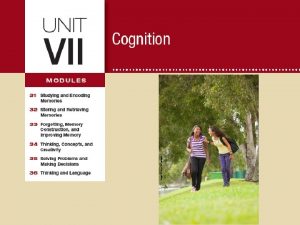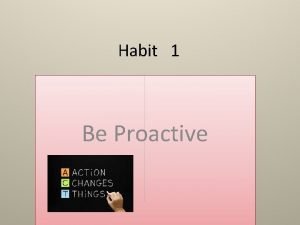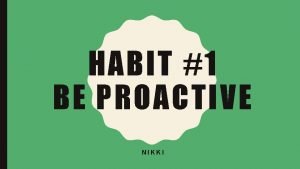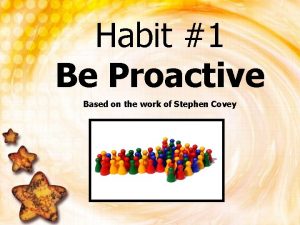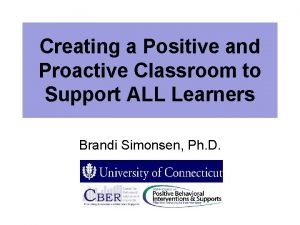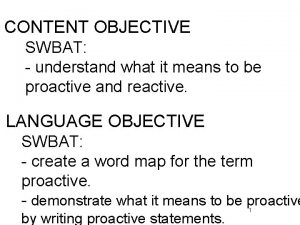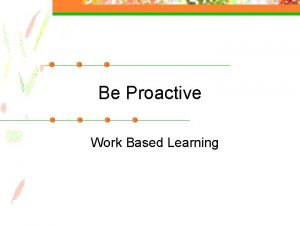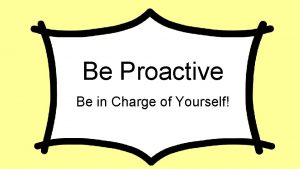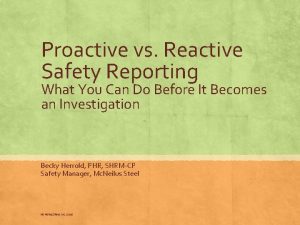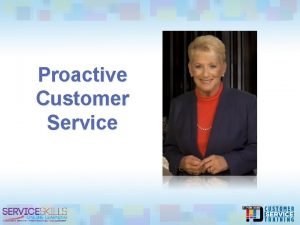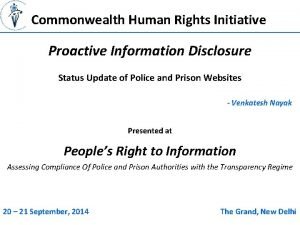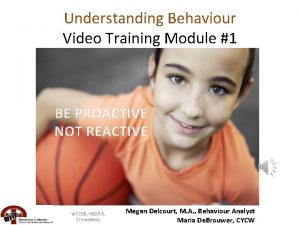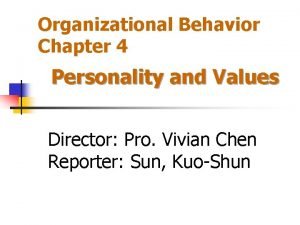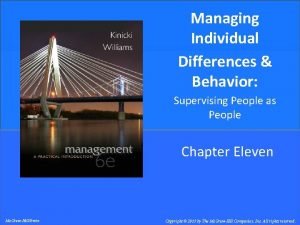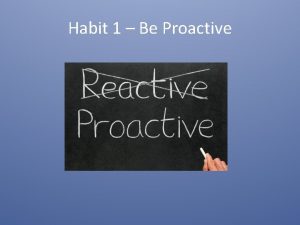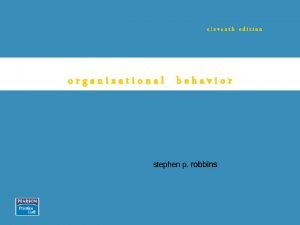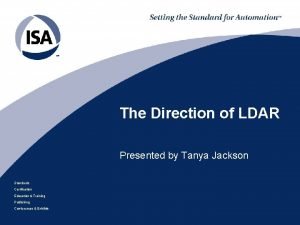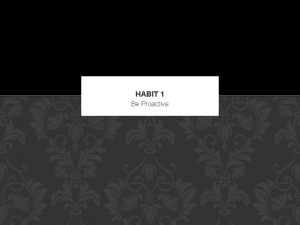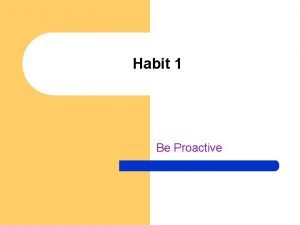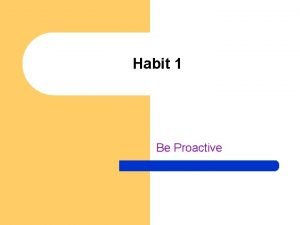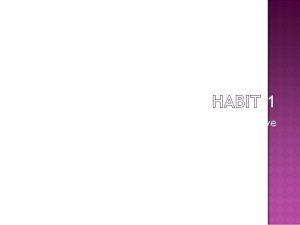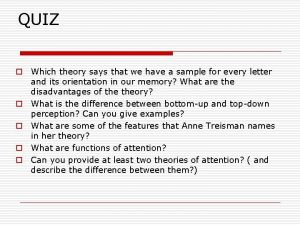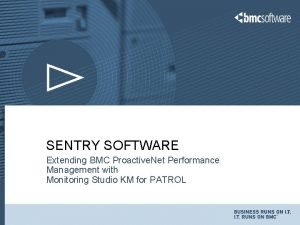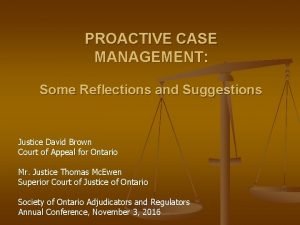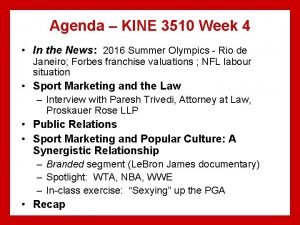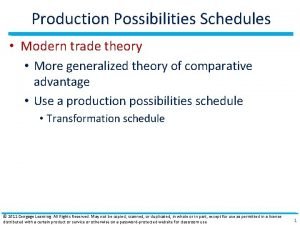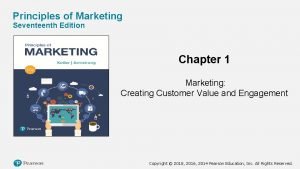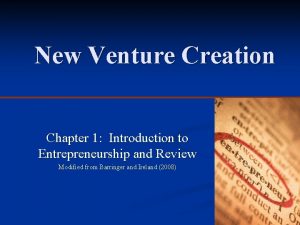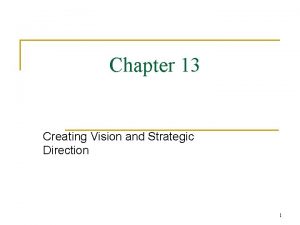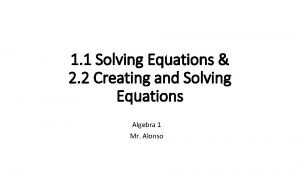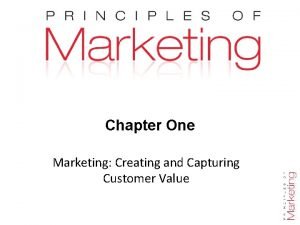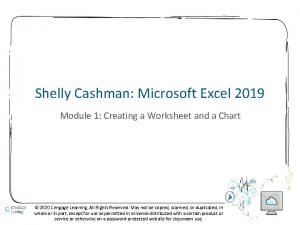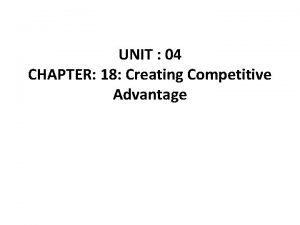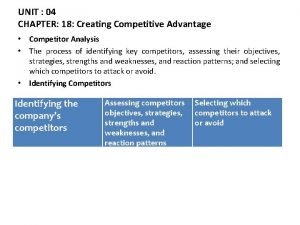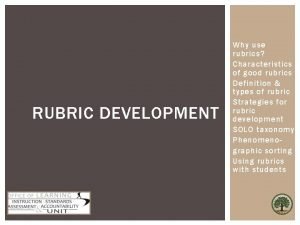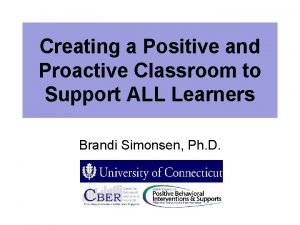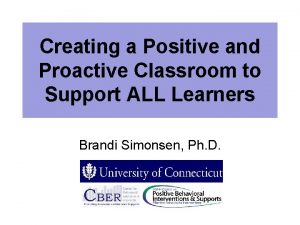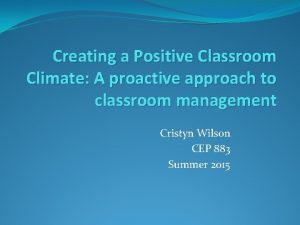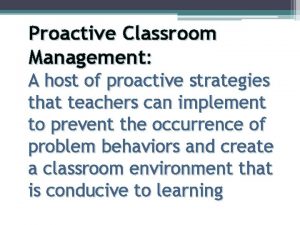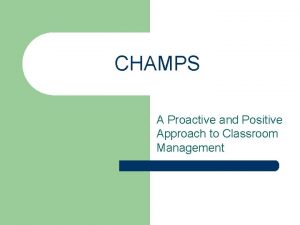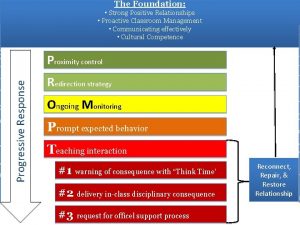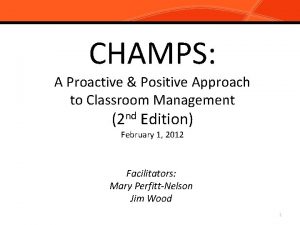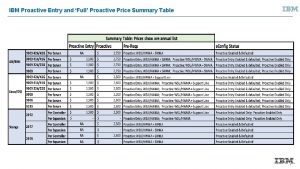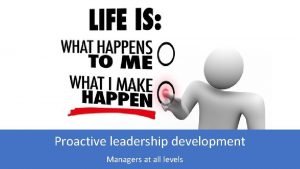Creating a Positive and Proactive Classroom to Support




















































































- Slides: 84

Creating a Positive and Proactive Classroom to Support ALL Learners Brandi Simonsen, Ph. D.

Workshop Overview Mon Class-wide Antecedent and Teaching Behavior Strategies (9: 30 -12: 30) Maximizing Structure, Classroom Expectations, & Active Engagement Class-wide Consequence Strategies Tue Acknowledging Appropriate and Responding to Inappropriate (9: 30 -12: 30) Behavior Wed Positive and Proactive Supports for ALL and Action Planning (9: 45 -12: 30) Applying Knowledge of Strategies to An Individual Classroom Thurs Developing Systems to Support Class-wide Support (8: 45 -10: 00, Taking your knowledge to scale (from one classroom to all 10: 30 -12: 30) classrooms)

Advance Organizer: Day 3 9: 45 -10: 00 -10: 45 -11: 00 Overview of the day & Brief Review Lecture & Discussion: Implementation Guide Review Supporting and Responding to Student Behavior BREAK 11: 00 -12: 00 Lecture & Discussion: Differentiating Supports for All Discuss Strategies to Intensify Positive and Proactive Supports 12: 00 -12: 15 Table Activity: Classroom Action Planning Update Action Plan to Include Strategies to Differentiate Supports 12: 15 -12: 30 Wrap-up Share out updated action plans Review and look toward tomorrow

Decision Making Guide for K-12 Classrooms* *Based on a soon-to-be-released Technical Assistance Brief on Classroom PBIS

Overview of Materials • Supporting and Responding to Student Behavior • Classroom Management Self-Assessment & Action Plan (We’ll Revisit the Draft You Developed Yesterday)

Where do we start? As a result of attending today’s training, you will be able to • Discuss the context in which positive classroom behavioral support (PCBS) practices are implemented. • Implement critical PCBS practices. • Differentiate PCBS practices, based on data, to support all learners. • Update your action plan to guide your own practice.

Goal of Teaching Student Achievement Good Teaching Classroom Management Behavior problems disrupt learning Engaging learning prevents behavior problems (Gest & Gest, 2005; Stronge, Ward and Grant, 2011)

United States, we have a problem! • 12% of public school teachers leave within their first 2 years • 50% leave within the first 5 years (Boyd, Grossman, Ing, Lankford, Loeb, & Wyckoff, 2011; De. Angelis, & Presley, 2011; Feng, 2006; Henke, Zahn, & Carroll, 2001; Ingersol, Merril, May, 2012; Johnson & Birkeland, 2003; Ingersoll & Smith, 2003; Kaiser & National Center for Educational Statistics, 2011; Kukla. Acevedo, 2009; Luekens, Lyter, Fox, & Changler, 2004; Smith & Ingersoll, 2004; Torres, 2012; Zabel & Zabel, 2002)

Why do teachers leave? • Most consistently listed factors: – Lack of pedagogical training – School environment – Poor student behavior and motivation • Teachers consistently report: – inadequate pre-service training on classroom management and – lack of support and training for handling student behaviors (Boyd, Grossman, Ing, Lankford, Loeb, & Wyckoff, 2011; Chesley & Jordan, 2012; Feng, 2006; Halford, 1998; Henke, Zahn, & Carroll, 2001; Ingersol, Merril, May, 2012; Johnson & Birkeland, 2003; Kukla-Acevedo, 2009; Lane, Wehby, & Barton-Arwood, 2005; Luekens, Lyter, Fox, & Changler, 2004; Stough, 2006; Torres, 2012; Zabel & Zabel, 2002) Supporting teachers in classroom PBIS is critical for our teachers, schools, and our country!

How can we support teachers? What do we know from the empirical literature? • Multi-component training packages (didactic training+coaching +performance feedback+etc. ) result in desired increases in teachers’ positive classroom behavior support practices. (Abbott et al. , 1998; Hiralall & Martens, 1998; Madsen, Becker, & Thomas, 1968; Freeman et al. , under review; The Metropolitan Area Child Study Research Group & Gorman-Smith, 2003; Rollins et al. , 1974)

What about the kids? • Students benefit when teachers implement evidence-based PCBS practices. 1 • Unfortunately, we’re not there yet. – Teachers implement PCBS practices at lower rates (see data on next slide) than desired. 2 – Students with challenging behavior experience even less praise, fewer opportunities to respond, more reprimands, and more negative or coercive interactions. 3 (Simonsen, Fairbanks, Briesch, Myers, & Sugai, 2008) Herman, & Stormont, 2012; Scott, Alter, & Hirn, 2011) 3 (e. g. , Carr, Taylor & Robinson, 1991; Kauffman & Brigham, 2009; Scott et al. , 2011; Sutherland & Oswald, 2005) 1 2 (Reinke,

Typical Implementation Rates of PCBS Practices Specific Praise General Praise OTR Corrective/ Reprimand Reinke et al. (2012)1 0. 13 0. 43 1. 43 0. 67 Scott et al. (2011)2 0. 06 (overall positive) 0. 57 0. 07 Hirn & Scott (2014)3 0. 03 (overall positive) 0. 47 Group 0. 06 Indiv. 0. 08 Pas et al. (2015)4 0. 12 (approval) 0. 93 0. 27 Based on observations of 33 elementary teachers in schools implementing PBIS with fidelity 2 Based on > 1000 observations of elementary and high school teachers in schools not identified as implementing PBIS 3 Based on 827 observations of high school teachers 4 Based on observations of 1262 high school teachers prior to PBIS implementation 1

We can do this! • We need to support teachers implementation of evidence based classroom management practices…. . and we can! – We know what evidence based classroom management practices look like. – We have a science to support implementation. – We have tools to describe and illustrate what implementing evidence based classroom management “looks like. ” • So, what are we waiting for?

Let’s get started! As a result of attending this training, you will be able to • Discuss the context in which positive classroom behavioral support (PCBS) practices are implemented. • Implement critical PCBS practices. • Differentiate PCBS practices, based on data, to support all learners. • Update your action plan to guide your own practice.

Before jumping into content, let’s preview the features of this resource (purple slides). Developed by: Brandi Simonsen, Jennifer Freeman, Steve Goodman, Barbara Mitchell, Jessica Swain-Bradway, Brigid Flannery, George Sugai, Heather George, Bob Putnam, &Renee Bradley et al. (OSEP) (Simonsen & Freeman, 2017)

Interactive Map of Core Features

Self-Assessment

Decision Making Chart

Tables with Definitions, Examples, Non-Examples, and Resources

Additional Tools

Scenarios to Illustrate Implementation

PCBS Practices Decision-making Guide: 3 Key Questions Are the foundations of effective Now Jump Into the PCBS Practices PCBSLet’s in place? Are proactive and positive PCBS practices implemented consistently? Do data indicate that students are still engaging in problem behavior? (Simonsen & Freeman, 2017)

PCBS Practices Decision-making Guide: 3 Key Questions Are the foundations of effective PCBSdesign in place? Effectively the physical environment of the classroom Are proactive and positive PCBS Elementary Example: HS Example: practices Plan layout accordingimplemented Plan layout according consistently? to the type of activity (e. g. , tables for (e. g. , “U” or circle for centers, separate discussion, forward desks for independent facing for group Do data that students are still work, circle area for indicate instruction) engaging in problem behavior? group instruction) (Simonsen & Freeman, 2017) Non-Example: Disorderly, messy, unclean, and/or visually unappealing environment

Are the foundations of effective PCBS in place? Effectively design the physical environment of the classroom + Elementary Example: Establish routines and procedures for: • Arrival and dismissal • Transitions between activities • Accessing help • What to do after work is completed (Simonsen & Freeman, 2017) Develop & teach predictable classroom routines. HS Example: Consider routines and procedures for: • Turning in work • Accessing materials • Making up missed work • Transitions/interrupti ons Non-Example: Assuming students automatically know routines & procedures without instruction and feedback

Are the foundations of effective PCBS in place? Effectively design the physical environment of the classroom + Elementary Example: • Poster of Be Safe, Kind, & Ready • Matrix to define for each classroom routine. • Teach engaging lessons for each expectation (Simonsen & Freeman, 2017) Develop & teach predictable classroom routines. + HS Example: • Student-created poster of Citizenship, Achievement, & Grit • Engage students in developing the matrix and teaching each lesson using video, etc. Post, define, & teach 35 positive classroom expectations. Non-Example: • Assuming students will already know your expectations • Having more than 5 expectations • Listing only behaviors you do NOT want from students

PCBS Practices Decision-making Guide: 3 Key Questions Are the foundations of effective PCBS place? Provide highinrates of varied opportunities to respond. Are proactive and positive PCBS Elementary Example: HS Example: practices implemented • Individual or small group: consistently? Student group: I just showed names on sticks in a you how to do #1, I jar. As questions are am going to start #2. posed, a student Secondthat row, students help Do data indicate name is drawn. explain my steps. still engaging in problem • Choral: All students • Nonverbal: Clickers behavior? recite letter sounds. to respond a, b, or c. (Simonsen & Freeman, 2017) Non-Example: • A teacher provides a 20 -minute lesson without asking any questions or prompting any are student responses.

Are proactive and positive PCBS practices implemented consistently? Provide high rates of varied opportunities to respond. + Elementary Example: • Before students begin seatwork, provide a reminder about how to access help and materials, if needed. • Poster of expected behaviors. (Simonsen & Freeman, 2017) Use prompts and active supervision. HS Example: • Review of group activity participation rubric prior to the start of group work. • Sign above the homework (HW) basket with checklist for handing in HW. Non-Example: • While teaching a lesson, a student calls out and the educator states, “Instead of calling out, I would like you to raise your hand. ”

Are proactive and positive PCBS practices implemented consistently? Provide high rates of varied opportunities to respond. + Elementary Example: • While students are working independently in centers scan and move around the classroom, checking in with students. (Simonsen & Freeman, 2017) Use prompts and active supervision. HS Example: • While monitoring students, move around the area, interact with students and observe behaviors of individuals and the group. Non-Example: • Sitting or standing where you cannot see the entire room / space. Such as with your back to the group or behind your desk.

Are proactive and positive PCBS practices implemented consistently? Provide high rates of varied opportunities to respond. + Elementary Example: • During educatordirected instruction, a student raises her hand. The educator says, “Thank you for raising your hand. ” (Simonsen & Freeman, 2017) Use prompts and active supervision. HS Example: • The teacher quietly states, “I really appreciate how you facilitated your group discussion. Peers had many ideas, and you managed it well. ” + Acknowledge behavior with specific praise & other strategies. Non-Example: • “Thank you for trying to act like a human. ” (This, at best, is sarcasm, not genuine praise. )

Other Strategies to Acknowledge Behavior Contract Group Contingency Token Economy Elementary Example: HS Example: Non-example Class Constitution signed by all Integrity Pledge signed by all Zero Tolerance Acknowledgement “If all students will hand in homework #2 by the due date, next Friday we will play State Bingo instead of a formal test review. ” “If we generate 5 questions that are examples of ‘Synthesis’ by 2: 15, you may sit where you would like for the last 20 mins of class. ” Making the goal unattainable or undeliverable, or singling out a student for failing to meet goal. “Group 2, you were all respectful during your discussion, and each of you earned a “star buck” to use in the school-wide store. ” “Alyiah, you were very respectful when your peer came in and asked for space. You’ve earned 10 bonus points toward your behavior goal. ” Providing points or tokens without (a) specific praise or (b) demonstrated behaviors (Simonsen & Freeman, 2017)

PCBS Practices Decision-making Guide: 3 Key Questions Are students still engaging in Are the foundations of problem effective behavior? PCBS in place? Yes No Are behaviors minor Well done! Monitor or major expectation outcomes and adjust violations? proactive and positive PCBS as needed Are practices Minorimplemented Major consistently? Use brief, specific How many students error correction & other strategies are involved (many or few)? Do data indicate Many that students are Few still engaging in problem Review, adjust & Request additional behavior? intensify CWPBIS. (tier 2 & 3) support (Simonsen & Freeman, 2017) Ask for help! for students.

Elementary Example: HS Example: • After a student calls • After student plays out in class Usethe brief, specific with lab equipment teacher responds, error correction & inappropriately, “Please raise your other strategies teacher responds, hand before calling “Please don’t play out your answer” with lab equipment, keep it on the table. ” (Simonsen & Freeman, 2017) Non-Example: • Shouting, “No!” (This is not calm, neutral, or specific. ) • A 5 -min conversation about what the student was thinking. (This is not brief. )

Other Strategies to Respond Elementary Example: HS Example: Non-example Planned Ignoring During a whole group activity, James shouts the teachers’ name to get her attention. The teacher ignores the callouts and proceeds with the activity. During a lecture, Jen interrupts the teacher and loudly asks her question. The teacher ignores Jen until she quietly raises her hand. A student is loudly criticizing a peer, resulting in other students laughing at the targeted peer. The teacher does nothing. Differential SR In the same scenario above, the teacher ignores James’ callouts, but immediately calls on and praises James when he raises his hand, “That’s how we show respect! Nice hand raise. ” (DRA) “If we can make it through this discussion without inappropriate language, you can listen to music during your independent work time at the end of class. ” (DRO) The teacher reprimands students each time they engage in problem behavior and ignore appropriate behavior. (Simonsen & Freeman, 2017)

Other Strategies to Respond Response Cost Elementary Example: HS Example: Non-example When a student talks out, the teacher pulls the student aside, provides a quiet specific error correction, and removes a marble from his/her jar on the teacher’s desk. When a student engages in disrespectful language, the teacher privately provides feedback and removes a point from the student’s point card. The teacher publicly flips a card (from green to red) to signal the student has lost privileges. When asked why, the teacher states, “you know what you did. ” When a student disrupt a preferred art class, the teacher asks the student to “take 5” to review the expectations in art. The student re-joins the class after restating expectations. Sending the student from a difficult, disliked class to inschool suspension, which is facilitated by a preferred adult and often attended by preferred peers for the remainder of the day. After throwing a game piece at a peer, the teacher removes the game from the student, asks her to Time Out return to her desk, from SR and reviews expectations before allowing her to resume (Simonsen & Freeman, 2017) activities.

Let’s get started! As a result of attending this training, you will be able to • Discuss the context in which positive classroom behavioral support (PCBS) practices are implemented. • Implement critical PCBS practices. • Differentiate PCBS practices, based on data, to support all learners. • Update your action plan to guide your own practice.

Do data indicate that students are still engaging in problem behavior? Are students still engaging in problem behavior? Yes No Are behaviors minor or major expectation violations? Minor Well done! Monitor outcomes and adjust as needed Major Use brief, specific error correction & other strategies How many students are involved (many or few)? Many Few Review, adjust & intensify CWPBIS. Ask for help! Request additional (tier 2 & 3) support for students.

Request additional (tier 2 & 3) support for students. Is there a targeted group of students displaying frequent, but minor challenging behaviors? Are there individual students displaying chronic or high intensity problem behaviors? Yes Coordinated plan via Wraparound Process FBA BSP Invest in Tier 3 Supports for identified individual students Individualized Function-Based Support Social Skills Groups Check, Connect, & Expect Check & Connect Check-In/ Check-Out Invest in Tier 2 Supports for identified targeted group

Rate of Referrals per Instructional Day Major and Minor Office Referrals Per Month Baseline • Principal and two second grade teachers requested support due to high numbers of office referrals Month (Fairbanks, Sugai, Guardino, & Lathrop, 2007)

Do data indicate that students are still engaging in problem behavior? Are students still engaging in problem behavior? Yes No Are behaviors minor or major expectation violations? Minor Well done! Monitor outcomes and adjust as needed Major Use brief, specific error correction & other strategies How many students are involved (many or few)? Many Few Review, adjust & intensify CWPBIS. Ask for help! Request additional (tier 2 & 3) support for students.

Rate of Referrals per Instructional Day Major and Minor Office Referrals Per Month Baseline • Principal and two second grade teachers requested support due to high numbers of office referrals • They emphasized Tier 1 supports based on school-wide PBIS approach (throughout study) • Explicit teaching and prompting expected behaviors • School-wide respect tickets Month (Fairbanks, Sugai, Guardino, & Lathrop, 2007)

Do data indicate that students are still engaging in problem behavior? Are students still engaging in problem behavior? Yes No Are behaviors minor or major expectation violations? Minor Well done! Monitor outcomes and adjust as needed Major Use brief, specific error correction & other strategies How many students are involved (many or few)? Many Few Review, adjust & intensify CWPBIS. Ask for help! Request additional (tier 2 & 3) support for students.

Request additional (tier 2 & 3) support for students. Is there a targeted group of students displaying frequent, but minor challenging behaviors? Are there individual students displaying chronic or high intensity problem behaviors? Yes Coordinated plan via Wraparound Process FBA BSP Invest in Tier 3 Supports for identified individual students Individualized Function-Based Support Social Skills Groups Check, Connect, & Expect Check & Connect Check-In/ Check-Out Invest in Tier 2 Supports for identified targeted group

Referral, Assessment, & Orientation CICO Cycle (Crone, Horner, & Hawken, 2004) Preview of Tier 2 Content CICO Plan Morning Check-In Weekly BEP Meeting Daily Teacher Evaluation Home Check-In 9 Week Graph Sent Program Update Afternoon Check-In EXIT

Check-In/Check-Out Point Card: Based on School-Wide Expectations (Fairbanks, Sugai, Guardino, & Lathrop, 2007)

% of Intervals Engaged in Problem Behavior Baseline CICO Intervention • Identified students who Helena did not respond to Tier 1 (high or increasing problem behavior) Jade • Implemented a Check. In/Check-Out (CICO) intervention with these Randy students • For these four students, levels of Farell problem behavior decreased on CICO • These students were “CICO responders” (Fairbanks, Sugai, Guardino, & Lathrop, 2007)

% of Intervals Engaged in Problem Behavior Baseline CICO Intervention • Identified students who Marcellus did not respond to Tier 1 and implemented CICO (Tier 2) intervention Blair with these students • For these four students, levels of Ben problem behavior maintained or increased on CICO Olivia (Fairbanks, Sugai, Guardino, & Lathrop, 2007)

Request additional (tier 2 & 3) support for students. Is there a targeted group of students displaying frequent, but minor challenging behaviors? Are there individual students displaying chronic or high intensity problem behaviors? Yes Coordinated plan via Wraparound Process FBA BSP Invest in Tier 3 Supports for identified individual students Individualized Function-Based Support Social Skills Groups Check, Connect, & Expect Check & Connect Check-In/ Check-Out Invest in Tier 2 Supports for identified targeted group

Individualized Behavioral Interventions Preview of Tier 3 Content • Students benefit from function-based support (e. g. , Crone & Horner, 2003) – All behavior occurs in a context. – By looking at the behavior in context, we can hypothesize about the function of a student’s behavior.

Behavior Support Elements *Response class *Routine analysis *Hypothesis statement *Function Problem Behavior *Alternative behaviors *Competing behavior analysis *Contextual fit *Strengths, preferences, & lifestyle outcomes *Evidence-based interventions Functional Assessment Intervention & Support Plan *Implementation support *Data plan Fidelity of Implementation • Team-based • Behavior competence *Continuous improvement *Sustainability plan Impact on Behavior & Lifestyle

3 Basic Steps: Developing interventions for Individual Students 3. Develop intervention strategies 2. Choose replacement behaviors 1. Look at the function of behavior

r e b m ns e o m i t e R unc F SR+ SR-

1. Look at the Function of Behavior What typically precedes? What do the behaviors look like? What typically follows? Based on observing these patterns across time, what is the probable function of the behavior?

FBA: Collecting Information An FBA involves collecting information from multiple sources through a variety of methods across time, including: Records Reviews Interviews Direct Observations Experimental Analysis (Structural/Functional)

3 Basic Steps: Developing interventions for Individual Students 3. Develop intervention strategies 2. Choose replacement behaviors 1. Look at the function of behavior

Fundamental Rule “You should not propose to reduce a problem behavior without also identifying alternative, desired behaviors person should perform instead of problem behavior” (O’Neill et al. , 1997, p. 71).

2. Choose a Desired Behavior The desired behavior should be what is expected given the same antecedent event/condition. It likely results in different consequences. DESIRED BEHAVIOR PROBLEM BEHAVIOR NATURAL CONSEQUENCE (in typical instructional conditions) MAINTAINING CONSEQUENCE (FUNCTION)

2. Choose a Replacement Behavior The replacement behavior should be more efficient and effective at achieving maintaining reinforcer (i. e. , meeting the same function). MAINTAINING CONSEQUENCE (FUNCTION) PROBLEM BEHAVIOR REPLACEMENT BEHAVIOR HELP

3 Basic Steps: Developing interventions for Individual Students 3. Develop intervention strategies 2. Choose replacement behaviors 1. Look at the function of behavior

3. Develop Intervention Strategies Based on our understanding of the context of problem behavior, we then begin to develop intervention strategies. ANTECEDENT MANIPULATIONS INSTRUCTIONAL STRATEGIES CONSEQUENCE MANIPULATIONS Ways to prevent the occurrence of behavior Ways to teach replacement behavior AND shape replacement behavior into desired behavior Ways to (a) increase occurrences of replacement and desired behaviors and (b) decrease occurrences of target behaviors …to make the problem behavior IRRELEVANT …to make the problem behavior INEFFICIENT …to make the problem behavior INEFFECTIVE

More specifically… SE or MO MANIPULATIONS • Minimize the likelihood • Neutralize • Withhold SD • Add prompts • Increase reinforcement for desired behavior ANTECEDENT MANIPULATIONS • Redesign the environment • Physical arrangement • Predictability • Choice • Instructional variables • Add Prompts and/or precorrections WAYS TO TEACH BEHAVIORS • Develop objectives • Teach replacement behavior • Shift from replacement to desired behavior CONSEQUENCE MANIPULATIONS • Increase function-based reinforcement for replacement behavior • Increase reinforcement for desired behavior • Prevent reinforcement for problem behaviors

% of Intervals Engaged in Problem Behavior Baseline CICO Intervention • Identified students who Marcellus did not respond to Tier 1 and implemented CICO (Tier 2) intervention Blair with these students • For these four students, levels of Ben problem behavior maintained or increased on CICO Olivia • Implemented functionbased plan and student’s problem behavior decreased (Fairbanks, Sugai, Guardino, & Lathrop, 2007)

Rate of Referrals per Instructional Day Major and Minor Office Referrals Per Month Baseline Intervention What were the overall effects for classroom? Month (Fairbanks, Sugai, Guardino, & Lathrop, 2007)

PCBS Practices Decision-making Guide: 3 Key Questions Are the foundations of effective Now Jump Into the PCBS Practices PCBSLet’s in place? Are proactive and positive PCBS practices implemented consistently? Do data indicate that students are still engaging in problem behavior? So, what does this actually look like in a classroom?

EX 1. Mr. Jorgé’s Third Grade Classroom

EX 1. Mr. Jorgé’s Third Grade Classroom Foundations Carefully designed his classroom before any of his 25 third graders arrived in the fall. • Planned his routines—from where students would place materials upon entering the room to where they would line up when getting ready to exit • Ensured the physical layout facilitated students engaging in routines. • Defined what it looked like for students to follow the school-wide expectations (Safety, Respect, and Responsibility) in the context of each of his classroom routines (using an expectations-within-routines matrix).

EX 1. Mr. Jorgé’s Third Grade Classroom Positive & Proactive CPBIS Practices At the beginning of the school year: • On the first day of school, Mr. Jorgé greeted students at the door, introduced himself, and invited students into their shared learning environment. • He spent the better part of the first day explicitly teaching the expectations within his classroom routines and establishing his classroom as a positive learning environment. • Throughout the day, he systematically recognized each student who followed the expectations with specific praise (e. g. , “Julie, remembering to bring your materials was really responsible. That’s a great way to start the year!”).

EX 1. Mr. Jorgé’s Third Grade Classroom Positive & Proactive CPBIS Practices • He also wrote and invited students to sign a “Classroom Constitution” (a. k. a. , behavior contract).

EX 1. Mr. Jorgé’s Third Grade Classroom Positive & Proactive CPBIS Practices After the first day, Mr. Jorgé kept up his part of the Class Constitution. • He greeted students every morning and provided reminders about expected behavior at the beginning of each activity (prompts). • He ensured his lessons were engaging and included multiple opportunities for students to respond and participate, and gave students specific feedback when they were doing well. • He continued to recognize appropriate student behavior with specific praise, and he found that most students were consistently demonstrating expected behavior.

EX 1. Mr. Jorgé’s Third Grade Classroom Minor Expectation Violations Occasionally, a student would engage in minor problem behavior (e. g. , calling out instead of raising a quiet hand). • Rather than getting upset, Mr. Jorgé remembered that this was just an error, and he provided a brief, specific error correction. • For these minor problem behaviors, Mr. Jorgé let students know their behavior was not appropriate, reminded them what was expected, and gave them an opportunity to practice and earn positive feedback: “Jeff, remember to raise your hand rather than call out. Let’s try that again. ” After Jeff quietly raises his hand, “Thanks for raising your hand, now what did you want to share? ” • For most students, this helped them get back on track and meet classroom expectations most of the time.

EX 1. Mr. Jorgé’s Third Grade Classroom Major Expectation Violations-Many After winter break, many students were engaging in consistent disruptive behavior and his reminders weren’t sufficient. Mr. Jorgé enhanced his CPBIS strategies. • He retaught expected behavior, revisited his Class Constitution, and provided additional prompts • He also introduced a new incentive: a token economy. Each student who was engaged in expected behavior when the mystery timer went off (a kitchen timer Mr. Jorgé would set for 15 -20 min) would earn a ticket, which they could use to purchase “gift cards” for classroom privileges (e. g. , homework pass, photocopying privileges, lunch with Mr. Jorgé in the classroom) at the end of the week. • With these added supports, the majority of students were again engaging in expected behavior.

EX 1. Mr. Jorgé’s Third Grade Classroom Major Expectation Violations-Few Despite his intensified intervention approach, Mr. Jorgé noticed that one student, Rob, was starting to display intense levels of behavior. Rob was frequently out of his seat, and he would often disrupt the learning of his peers by pushing their materials off of their desks when he walked by, calling his peers (and occasionally Mr. Jorgé) names under his breath, and shouting out repeatedly when Mr. Jorgé was teaching. • Mr. Jorgé brought his concerns (and data!) to the Student Assistance Team and requested assistance. • The team decided that Rob may need more comprehensive supports, and contacted Rob’s parents to obtain consent for further assessment.

EX 2. Dr. Rubert’s 9 th Grade Science Class E=MC 2

EX 2. Dr. Rubert’s 9 th Grade Science Class Foundations Before the start of her 16 th school year, Dr. R revisited her plan for her classroom and lab. • She ensured materials were stored safely and the furniture allowed students to successfully transition from desks to lab tables and back again, effectively designing the physical environment. • She clearly reviewed her routines and posted reminders of key routines in important places in the room.

EX 2. Dr. Rubert’s 9 th Grade Science Class Foundations • She further defined the same school-wide expectations (safety, respect, and achievement) for her three main classroom routines in her classroom matrix.

EX 2. Dr. Rubert’s 9 th Grade Science Class Foundations • On the first day, Dr. R greeted her students at the door. • She explicitly taught her expectations: – She reminded students of the school-wide expectations. – She showed a student-created video about how to demonstrate safety, respect, and achievement in the classroom (as all teachers were doing), and then further described what the expectations looked like during her lectures (MODEL). – She involved students in a quick check, where she read scenarios and asked if students in the scenario were meeting (or not meeting) each expectation (LEAD). – Then, she delivered the rest of her intro lecture and noted (using her electronic grade book app) which students were displaying expected behavior and which were not (TEST). – She repeated this process the first time she introduced lab and seatwork, and periodically throughout the year.

EX 2. Dr. Rubert’s 9 th Grade Science Class Positive & Proactive CPBIS Practices • Each day, Dr. R. greeted her students at the door, reminded them to get started on the activity listed on the Smartboard (routine), and provided any needed reminders about expectations for each new activity. • She ensured her brief lectures were engaging, and provided guided notes to increase opportunities to respond. She also included interactive lab activities. • She consistently gave students specific feedback when they were engaging in expected appropriate behavior (e. g. , “Thanks for handling those materials safely. I can see you are ready for more advanced labs. ”). • She also praised herself for “rocking CPBIS!”

EX 2. Dr. Rubert’s 9 th Grade Science Class Minor Expectation Violations Occasionally, students would engage in minor problem behaviors (e. g. , during a transition, a couple of students were using their fingers like hockey sticks and Petri plastic dishes as pucks on a lab table). • She took a breath, resisting the urge to react with a harsh or loud tone, and instead reminded them how to use materials safely (brief error correction). • She had them show her where the dishes should be stored when not in use (opportunity to practice), and she thanked them for getting back on track so she could finish setting up their lab (positive feedback).

EX 2. Dr. Rubert’s 9 th Grade Science Class Major Expectation Violations-Many As spring approached, Dr. R was starting to introduce more advanced lab experiences. However, students’ schedules were frequently disrupted by various activities (e. g. , field trips, spring fling), and she was seeing increased rates of inappropriate behavior. For example, when she first introduced Bunsen Burners, a few students played with the burners (while they were turned off) as though they were light sabers—playfully clinking the burners together. Other students laughed, and made fun of Dr. R when she tried to gently correct them.

EX 2. Dr. Rubert’s 9 th Grade Science Class Major Expectation Violations-Many • She reviewed/retaught expectations. • She also introduced a classroom group contingency around safe lab behavior: – If students were safe during all lab activities, they could do a “fun” lab at the end of each 2 -week unit. – If there was one instance of significantly unsafe behavior (i. e. , something that could put someone at risk of injury), then all labs were suspended until students could (a) pass a safety quiz, (b) demonstrate safe operation of lab equipment, and (c) sign a contract committing to using all materials safely. • With the added review, ongoing reminders, and group contingency, students were back on track with appropriate behavior.

EX 2. Dr. Rubert’s 9 th Grade Science Class Major Expectation Violations-Few Despite her best efforts at being proactive, one of Dr. R’s students was starting to concern her. Rachel was a student who often dressed in black and kept to herself. When Dr. R tried to approach her, Rachel would often stare blankly, make a rude comment, or walk away. • As data supported her initial concerns, Dr. R referred Rachel to the intensive intervention team (2 IT). • The 2 IT reviewed data, called Rachel’s parents, and proceeded with a functional behavioral assessment and an individualized behavior intervention plan. • The team also coordinated more intensive supports, developed in collaboration with Rachel and her family, using a wraparound process.

Let’s get started! As a result of attending this training, you will be able to • Discuss the context in which positive classroom behavioral support (PCBS) practices are implemented. • Implement critical PCBS practices. • Differentiate PCBS practices, based on data, to support all learners. • Update your action plan to guide your own practice.

Wrap-up of Day 3 & Look Toward Day 4

Decision-making Guide: 3 Key Questions Are the foundations of effective CPBIS in place? Effectively design the physical environment of the classroom + Develop & teach predictable classroom routines. + Post, define, & teach 3 -5 positive classroom expectations. Are proactive and positive CPBIS practices implemented consistently? Provide high rates of varied opportunities to respond. + Use prompts and active supervision. + Acknowledge behavior with specific praise & other strategies. Do data indicate that students are still engaging in problem behavior?

Are students still engaging in problem behavior? Yes No Are behaviors minor or major expectation violations? Minor Well done! Monitor outcomes and adjust as needed Major Use brief, specific How many students error & involved (many Do correction data indicate thatare students are still other strategies or few)? problem behavior? engaging in Many Few Review, adjust & intensify CWPBIS. Ask for help! Request additional (tier 2 & 3) support for students.
 Classroom atmosphere
Classroom atmosphere Diana browning wright
Diana browning wright Proactive classroom management
Proactive classroom management Diana browning
Diana browning Smart classroom vs traditional classroom
Smart classroom vs traditional classroom Fredric jones positive classroom discipline
Fredric jones positive classroom discipline Fredric jones positive classroom management
Fredric jones positive classroom management Grammatical signals examples
Grammatical signals examples Novobiocin test
Novobiocin test Negative number rules
Negative number rules Positive practice positive outcomes
Positive practice positive outcomes Positive behaviour support plan examples
Positive behaviour support plan examples Principles of positive behavior support for dsps
Principles of positive behavior support for dsps Primitive reflexes
Primitive reflexes Positive behavior support
Positive behavior support Positive support transition plan
Positive support transition plan Proactive interference vs retroactive interference
Proactive interference vs retroactive interference Repressed memories
Repressed memories Proactive planning and reactive planning
Proactive planning and reactive planning Proactive and reactive change
Proactive and reactive change Misleading graph
Misleading graph Risk information sheet in software engineering
Risk information sheet in software engineering Four pillars of sms
Four pillars of sms Goodyear proactive solutions
Goodyear proactive solutions Proactive international pr
Proactive international pr Proactive advocacy
Proactive advocacy Microsoft premier support services
Microsoft premier support services Proactive interference vs retroactive interference
Proactive interference vs retroactive interference Habit 1: be proactive examples
Habit 1: be proactive examples Proactive vs reactive worksheet
Proactive vs reactive worksheet Habit 1: be proactive reflection
Habit 1: be proactive reflection Proactive behavior examples
Proactive behavior examples Proactive vs reactive examples
Proactive vs reactive examples Proactive working
Proactive working Proactive vs reactive
Proactive vs reactive Proactive secure development
Proactive secure development Proactive vs reactive safety
Proactive vs reactive safety Proactive customer service definition
Proactive customer service definition Proactive commonwealth
Proactive commonwealth 7 habits poem
7 habits poem Be proactive video
Be proactive video Proactive fire solutions
Proactive fire solutions The 4 personality types
The 4 personality types Proactive risk management
Proactive risk management Managing individual differences and behavior
Managing individual differences and behavior Proactive vs reactive 7 habits
Proactive vs reactive 7 habits Proactive personality
Proactive personality Be proactive
Be proactive Proactive patient outreach
Proactive patient outreach Reactive language vs proactive language
Reactive language vs proactive language Proactive people make choices based on
Proactive people make choices based on Proactive people make choices based on
Proactive people make choices based on Carry your own weather
Carry your own weather Proactive coaching
Proactive coaching Proactive teacher
Proactive teacher Retroactive interference
Retroactive interference Telephone doctor customer service training
Telephone doctor customer service training Proactivenet performance management
Proactivenet performance management Proactive case management
Proactive case management Proactive kine
Proactive kine Creating production possibilities schedules and curves
Creating production possibilities schedules and curves Marketing chapter 1
Marketing chapter 1 Porters 3 generic strategy
Porters 3 generic strategy What are customer value satisfaction and loyalty
What are customer value satisfaction and loyalty Creating customer value satisfaction and loyalty
Creating customer value satisfaction and loyalty Inner defender and inner guide examples
Inner defender and inner guide examples Creating and starting the venture
Creating and starting the venture Vision focuses on the current reality and maintaining it
Vision focuses on the current reality and maintaining it 2-2 creating and solving equations
2-2 creating and solving equations Creating and capturing customer value
Creating and capturing customer value Marketing concept
Marketing concept Creating customer value satisfaction and loyalty
Creating customer value satisfaction and loyalty Excel module 1: creating a worksheet and a chart
Excel module 1: creating a worksheet and a chart An expanded model of the marketing process
An expanded model of the marketing process Interpreting distance time graphs
Interpreting distance time graphs Creating and interpreting distance time graph
Creating and interpreting distance time graph The american people creating a nation and a society
The american people creating a nation and a society Creating value and capturing value
Creating value and capturing value Elohim creating adam by william blake
Elohim creating adam by william blake Value creation strategy
Value creation strategy Chapter 18 creating competitive advantage
Chapter 18 creating competitive advantage The age of the dinosaurs text structure
The age of the dinosaurs text structure Whats a rubric
Whats a rubric You are creating in prtu the value fund portfolio
You are creating in prtu the value fund portfolio Creating energy was at the center of optical art.
Creating energy was at the center of optical art.
